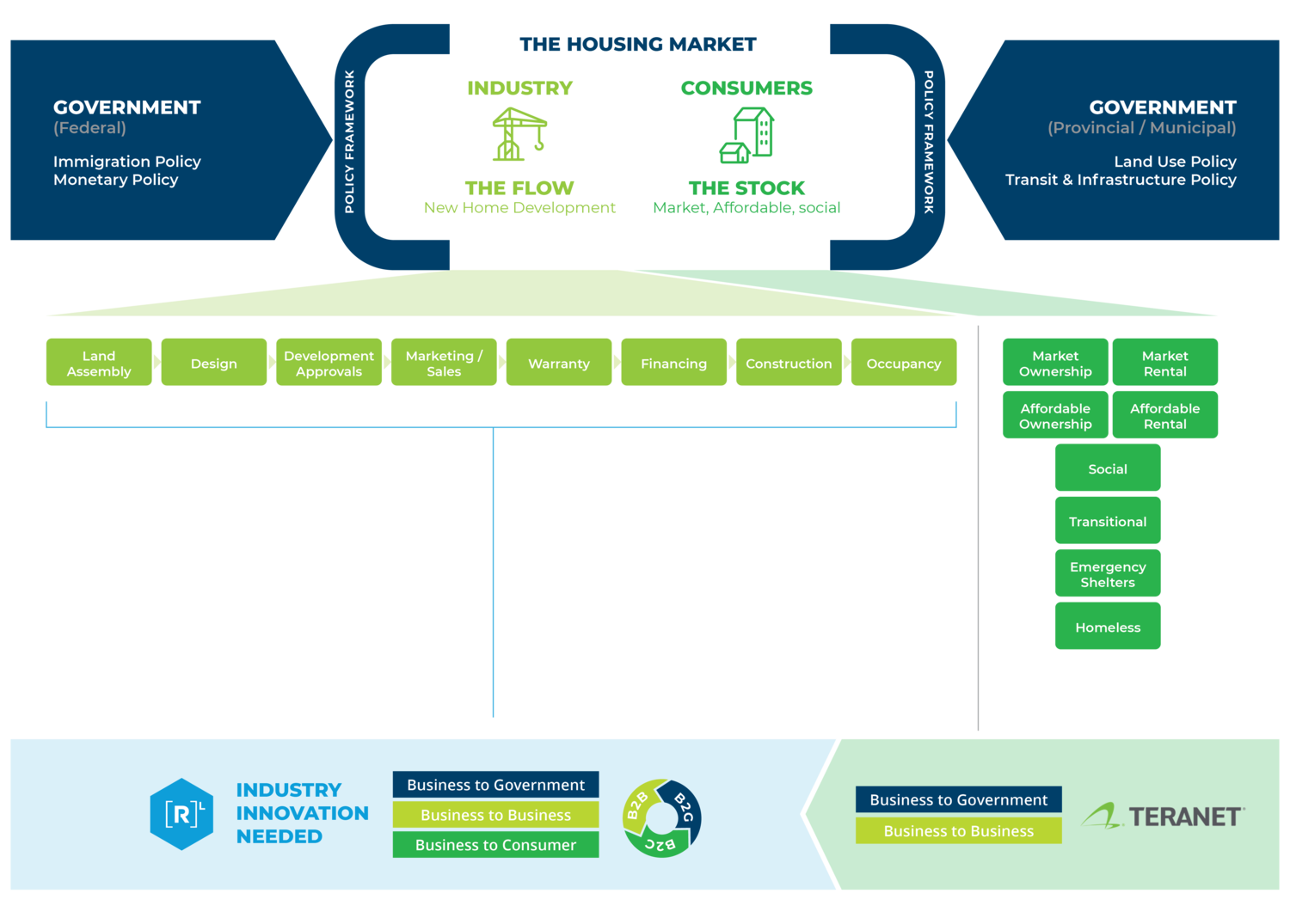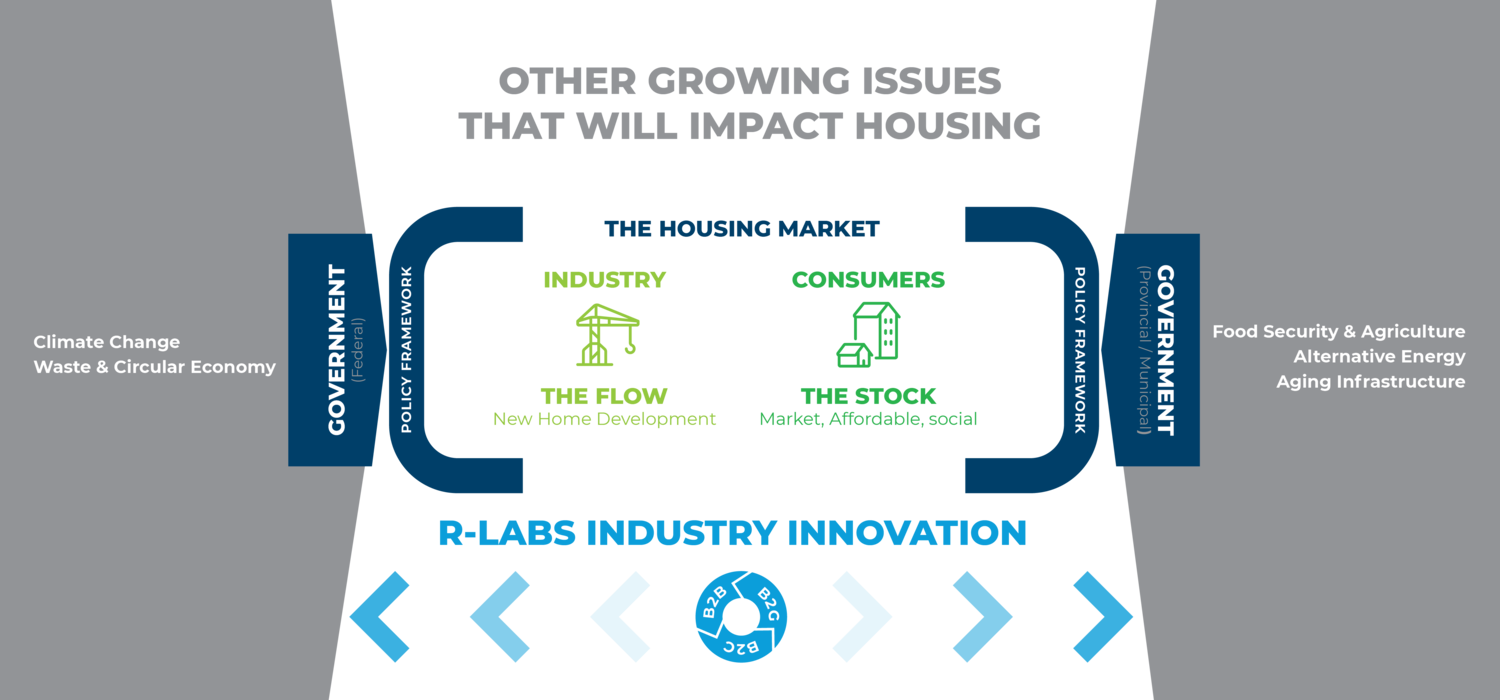Business to Business (B2B) and Business to Government (B2G) Industry Innovation Will Be Key to Improving the Flow in Housing Development
Housing in the Greater Golden Horseshoe (GGH) is critical, complicated, and no single entity is in charge. Housing markets operate within a policy framework that is governed across multiple levels of government. While federal levels of government control key components of the policy framework such as immigration levels and monetary and mortgage policies, provincial and municipal levels of government control equally important components of the policy framework including transit, infrastructure, land use and approvals.
Housing markets have two components: the stock and the flow. The stock represents the homes that physically exist and can be used for market or government assisted housing, and the flow is the process of creating and developing new homes.

Every home that exists in the stock today was created in the flow of the past, governed by the policy framework and development process of its time. With the population in the GGH set to grow from 10 million in 2021 to 14.9 million by 2051, the housing market flow will need to create a record supply of the right form of housing as stock.
Understanding the Problem
Based on the Hemson Greater Golden Horseshoe Outlook Report, the GGH is expected to grow by 154,000 per year on average, and that will require the creation of over 65,000 new homes per year to house the increased population. Looking back historically over a 15-year period however, the region has only been able to create an average of approximately 42,000 new homes annually. Without drastic improvements, there is good evidence to support the case that the region will undersupply approximately 23,000 homes per year (1/3 of what is needed) going forward.

But the housing problem is about more than just numbers. Housing is both a human right and an asset class. Housing means different things to different people across a continuum. It must be suitable, accessible, affordable, sustainable and address the full range of needs in a community and market.
Often words that sound the same can mean different things. Is affordable housing the same as housing affordability? It’s confusing – even at times to the experts. Affordable housing refers to government-subsidized housing for low-income people; housing affordability is a market outcome based on prices, incomes and mortgage rates and rules. Governments and the industry play different roles in this continuum as the needs for each vary significantly.
Solving both these problems in housing is the region’s future, and will not only require new thinking, but will also be highly dependent on the flow.

Role of Industry Innovation
While the housing problem is a problem that governments, industry, and consumers are all in together, expecting governments to provide all the solutions is unlikely to deliver the needed results. Industry innovation is growing to respond to the problems that lie ahead and can be delivered in three categories: B2C (Business to Consumer) innovation, B2B (Business to Business) innovation, and B2G (Business to Government) innovation.

In May of this year, Teranet joined R-LABS both investing in and expanding the partnership’s platform capabilities in delivering industry innovation.
Founded in 1991, Teranet has been an innovator in electronic registration and a trusted and dependable partner to governments for three decades building and operating a state-of-the-art land registry system – a key infrastructure to the stock of the housing market.
Teranet processes over 10 million land related transactions each year with the exclusive right to provide access to over 200 million document and plan images – playing a crucial role in providing the modern search and registration vehicle to almost 7 million properties in Ontario alone.
Through this access to housing data from the single source of truth, there is an integral opportunity to farm market intelligence that will drive, inform and validate innovation strategies across the real estate sector.
Industry innovation requires an in-depth understanding of stakeholder problems, their vectors (directions, magnitudes) and interrelationships. From there, innovators can create new technology-enabled business models to solve those problems.
Improving the flow in the housing market today is essential to the health of future stock. Everyone has a role to play in industry innovation with R-LABS. Extending the Business to Business and Business to Government innovation capabilities of Teranet from the housing market stock to improve the flow has great potential in the housing market.
Industry innovation is not fixed, rather expands in calculus proportionality to the problems it faces. And, given that the future challenges in housing will not be taking place in a vacuum, we will have to simultaneously address aging infrastructure, climate change, alternative energy, waste and the circular economy, food security, economic and social inclusion, pandemic recovery and more in unison.

The crisis in housing is not what is defining the future of the Greater Golden Horseshoe. What is defining the future, is the way in which we respond to the challenge. Industry innovation through R-LABS is a response that is creating opportunities of equal magnitude that are forming a global cluster of innovation in housing.





